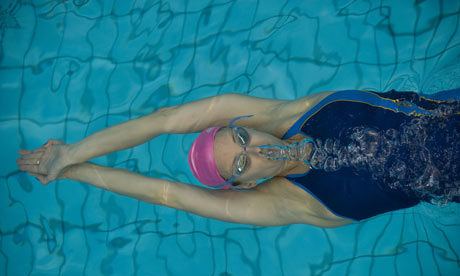Develop your backstroke technique

Karen Pickering demonstrating backstroke. Photograph: Tom Jenkins
Backstroke (or backcrawl) is the only competitive swimming stroke that starts in the water. The face remains out of the water, the disadvantage being that you can't see where you are going. Still, it is a great stroke for strengthening and toning the muscles without straining the back or neck. Here's how.
Body position: Sitting up in the water is the biggest mistake made in backstroke: if your hips drop too low, your body creates resistance which slows you down. Try and swim with your body close to the surface of the water - imagine you are lying in a bed with your head on a pillow - and push your tummy up to the ceiling, keeping your midriff flat.
Head: This stroke is led by the head which is fully supported by the water. The neck should be relaxed so that the head is held still. Common mistakes are to hold the head up too high causing strain or letting it fall to far backwards which can cause you to gulp water.
Breathing: Because the face is out of the water, breathing is generally easier than for other strokes. However, rhythm remains problematic for many. Breathe consistently and evenly.
Arms: The arms provide the power in backstroke. Elevate the right arm and lead with the thumb until it is level with the shoulder. Then, turn the palm outwards so that the little finger leads the up and over action. As the right arm is elevated, keep the left extended - it leads the way and helps balance the body. When the right arm moves towards the water, entering little finger first, bend the elbow and flex the wrist of the left arm, pushing it towards the feet. Make sure your hand, not your elbow, does the pushing. Keep pushing until the left elbow is straight before lifting it out of the body to begin another stroke.
Legs and feet: Although the arms provide power, the legs still contribute significantly to forward momentum. Try to keep legs close together throughout a stroke and use a long, shallow kick from the hips, not the knees. Keep your knees underwater and bent a little. Ankles should be floppy, not flexed, and turning the feet slightly inwards can help to achieve thi


0 comments
Post a Comment